by Eric Meier
When attempting to identify a wood sample, it’s important to keep in mind the limitations and obstacles that are present in our task. Before starting, please have a look at The Truth Behind Wood Identification to approach the task in a proper mindset; I consider the linked article to be required reading for all those visiting my site with the intent of identifying wood.
1. Confirm it is actually solid wood.
Before proceeding too much farther into the remaining steps, it’s first necessary to confirm that the material in question is actually a solid piece of wood, and not a man-made composite or piece of plastic made to imitate wood.
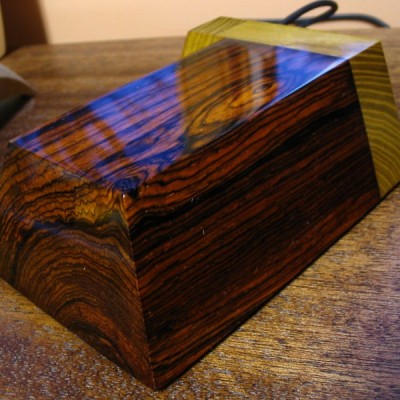
Can you see the end-grain?
Manufactured wood such as MDF, OSB, and particleboard all have a distinct look that is—in nearly all cases—easily distinguishable from the endgrain of real wood. Look for growth rings—formed by the yearly growth of a tree—which will be a dead-giveaway that the wood sample in question is a solid, genuine chunk of wood taken from a tree.
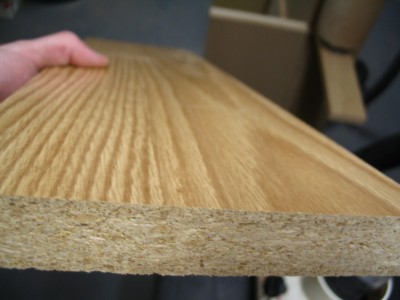
Is it veneered?
If you see a large panel that has a repeating grain pattern, it may be a veneer. In such cases, a very thin layer of real wood is peeled from a tree and attached to a substrate; sometimes the veneer can be one continuous repeating piece because it is rotary-sliced to shave off the veneer layer as the tree trunk is spun by machines. Assuming it is a real wood veneer with a distinct grain and texture—and not merely a piece of printed plastic—you may still be able to identify the outer veneer wood in question, but you should still realize that is it only a veneer and not a solid piece of wood.
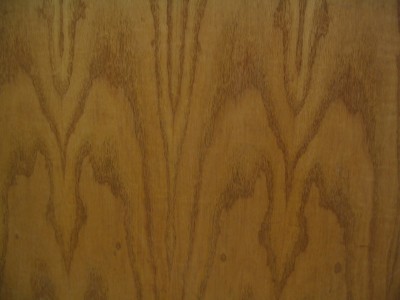
Is it painted or printed to look like wood?
Many times, especially on medium to large-sized flat panels for furniture, a piece of particleboard or MDF is either laminated with a piece of wood-colored plastic, or simply painted to look like wood grain. Many of today’s interior hardwood flooring planks are good examples of these pseudo-wood products: they are essentially a man-made material made of sawdust, glues, resins, and durable plastics.
2. Look at the color.
Some questions to immediately ask yourself:
Is the color of the wood natural, or is it stained?
If there is even a chance that the color isn’t natural, the odds are increased that the entire effort of identifying the wood will be in vain.
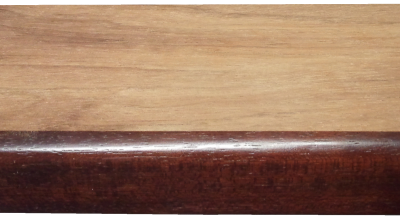
Is it weathered or have a patina?
Many woods, when left outside in the elements, tend to turn a bland gray color. Also, even interior wood also takes on a patina as it ages: some woods get darker, or redder, and some even get lighter or lose their color; but for the most part, wood tends to darken with age.
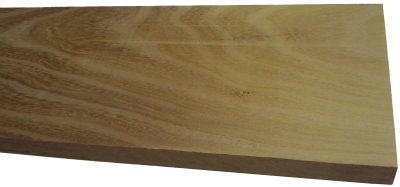
Is it possible to sand or plane the board to see the natural raw color of the wood?
The most predictable baseline to use when identifying wood is in a freshly sanded state. This eliminates the chances of a stain or natural aging skewing the color diagnosis of the wood.
3. Observe the wood grain.
If the wood is unfinished, then look at the texture of the grain. Ask yourself these questions:
Does the wood have an open, porous texture?
Most softwoods will be almost perfectly smooth with no grain indentations, while many common hardwoods have an open pore structure, such as oak or mahogany; though there are some hardwoods that are also smooth to the touch, such as maple.
Can you tell if the wood is quartersawn or plainsawn?
By observing the grain patterns, many times you can tell how the board was cut from the tree. Some wood species have dramatically different grain patterns from plainsawn to quartersawn surfaces. For instance, on their quartersawn surfaces, lacewood has large lace patterns, oak has flecks, and maple has the characteristic “butcher block” appearance.
Is there any figure or unusual characteristics, such as sapwood, curly or wild grain, burl/knots, etc.?
Some species of wood have figure that is much more common than in other species: for example, curly figure is fairly common in soft maple, and the curls are usually well-pronounced and close together. Yet when birch or cherry has a curly grain, it is more often much less pronounced, and the curls are spaced farther apart.
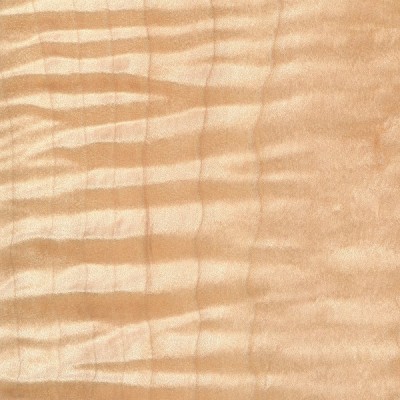
4. Consider the weight and hardness of the wood.
If it’s possible, pick the piece of wood up and get a sense of its weight, and compare it to other known wood species. Try gouging the edge with your fingernail to get a sense of its hardness. If you have a scale, you can take measurements of the length, width, and thickness of the wood, and combine them to find the density of the wood. This can be helpful to compare to other density readings found in the database. When examining the wood in question, compare it to other known wood species, and ask yourself these questions:
Is the wood dry?
Wood from freshly felled trees, or wood that has been stored in an extremely humid environment will have very high moisture contents. In some freshly sawn pieces, moisture could account for over half of the wood’s total weight! Likewise, wood that has been stored in extremely dry conditions of less than 25% relative humidity will most likely feel lighter than average.
How does the wood’s weight compare to other species?
Taking into account the size of the board, how does its weight compare to other benchmark woods? Is it heavier than oak? Is it lighter than pine? Look at the weight numbers for a few wood species that are close to yours, and get a ballpark estimate of its weight.
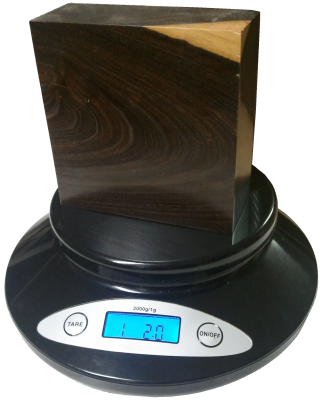
How hard is the wood?
Obviously softwoods will tend to be softer than hardwoods, but try to get a sense of how it compares to other known woods. Density and hardness are closely related, so if the wood is heavy, it will most likely be hard too. If the wood is a part of a finished item that you can’t adequately weigh, you might be able to test the hardness by gouging it in an inconspicuous area. Also, if it is used in a piece of furniture, such as a tabletop, a general idea of its hardness can be assessed by the number and depth of the gouges/dings in the piece given its age and use. A tabletop made of pine will have much deeper dents than a tabletop made of Oak. Additionally, you can always try the “fingernail test” as a rough hardness indicator: find a crisp edge of the wood, and with your fingernail try to push in as hard as you can and see if you’re able to make a dent in the wood.
5. Consider its history.
Many times we forget common sense and logic when attempting to identify wood. If you’ve got a piece of Amish furniture from Pennsylvania, chances are more likely that the wood will be made of something like black walnut or cherry, and not African wenge or jatoba. You might call it “wood profiling,” but sometimes it can pay to be a little prejudiced when it comes to wood identification. Some common-sense questions to ask yourself when trying to identify a piece of wood:
Where did it come from?
Knowing as much as you can about the source of the wood—even the smallest details—can be helpful. If the wood came from a wood pile or a lumber mill where all the pieces were from trees processed locally, then the potential species are immediately limited. If the wood came from a builder of antique furniture, or a boat-builder, or a trim carpenter: each of these occupations will tend to use certain species of woods much more often than others, making a logical guess much simpler.
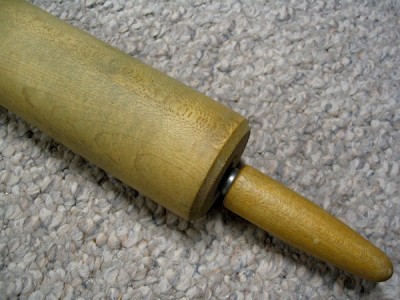
How old is it?
As with the wood’s source, its age will also help in identification purposes. Not only will it help to determine if the wood should have developed a natural patina, but it will also suggest certain species which were more prevalent at different times in history. For instance, many acoustic guitars made before the 1990s have featured Brazilian rosewood backs/sides, yet due to CITES restrictions placed upon that species, East Indian rosewood became a much more common species on newer guitars. (And this is a continuing shift as newer replacements are sought for rosewoods altogether.)
How large is the piece of wood?
Some species of trees are typically very small—some are even considered shrubs—while others get quite large. For instance, if you see a large panel or section of wood that’s entirely black, chances are it’s either painted, dyed, or stained: Gaboon ebony and related species are typically very small and very expensive.
What is the wood’s intended use?
Simply knowing what the wood was intended for—when considered in conjunction with where it came from and how old it is—can give you many clues to help identify it. In some applications, certain wood species are used much more frequently than others, so that you can make an educated guess as to the species of the wood based upon the application where it was used. For instance, in the United States: many older houses with solid hardwood floors have commonly used either red oak or hard maple; many antique furniture pieces have featured quartersawn white oak; many violins have spruce tops; many closet items used aromatic red cedar, and so forth. While it’s not a 100% guarantee, “profiling” the wood in question will help reduce the number of possible suspects, and aid in deducing the correct species.
6. Find the X-Factor.
Sometimes, after all the normal characteristics of a sample have been considered, the identity of the wood in question is still not apparent. In these instances—particularly in situations where a sample has been narrowed down to only a few possible remaining choices—it’s sometimes helpful to bring in specialized tests and other narrower means of identification.
The following techniques and recommendations don’t necessarily have a wide application in initially sorting out wood species and eliminating large swaths of wood species, but will most likely be of use only as a final step in special identification circumstances.
Odor
Believe it or not, freshly machined wood can have a very identifiable scent. When your eyes and hands can’t quite get a definitive answer, sometimes your nose can. Assuming there is no stain, finish, or preservative on or in the wood, quickly sand, saw, or otherwise machine a section of the wood in question, and take a whiff of the aroma.
Although new scents can be very difficult to express in words, many times the scent of an unknown wood may be similar to other known scents. For instance, rosewoods (Dalbergia spp.) are so named for their characteristic odor that is reminiscent of roses. Although difficult to directly communicate, with enough firsthand experience scents can become a memorable and powerful means of wood identification.
Fluorescence
While certain woods can appear basically identical to one another under normal lighting conditions, when exposed to certain wavelengths—such as those found in blacklights—the wood will absorb and emit light in a different (visible) wavelength. This phenomenon is known as fluorescence, and certain woods can be distinguished by the presence or absence of their fluorescent qualities. See the article Fluorescence: A Secret Weapon in Wood Identification for more information.
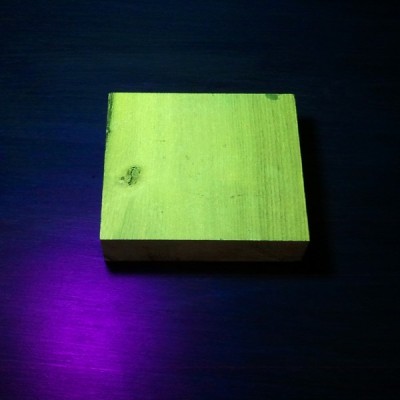
Chemical Testing
There are only a small number of chemical tests regularly used on wood, most of which are very specialized and were developed to help distinguish easily confused species with one another. They work by detecting differences in the composition of heartwood extractives. A chemical substance (called a reagent) is usually dissolved in water and applied to the wood surface: the surface is then observed for any type of chemical reaction (and accompanying color change) that may occur. Two of the most useful are the tests that are meant to separate Red and White Oak, and Red and Hard Maple.
Heartwood Extractives Leachability
Sometimes a wood species will have heartwood extractives that will be readily leachable in water and capable of conspicuously tinting a solution of water a specific color. For instance, the heartwood extractives contained in osage orange (Maclura pomifera) contain a yellowish-brown dye that is soluble in water. (This can sometimes be observed anecdotally when the wood is glued with a water-based adhesive: the glue’s squeeze-out is an unusually vibrant yellow.)
In a simple water extract color test, wood shavings are mixed with water in a vial, test tube, or other suitably small container, and the color of the water is observed after a few minutes. If the heartwood extractives are leachable by water, then a corresponding color change should quickly occur.
In addition to osage orange (Maclura pomifera), merbau (Intsia spp.), and rengas (Gluta spp. and Melanorrhoea spp.) are also noted for their readily leachable heartwood extractives. Because this property is quite uncommon, it can serve to quickly differentiate these woods from other lookalikes.
7. Look at the endgrain.
Perhaps no other technique for accurate identification of wood is as helpful and conclusive as the magnified examination of the endgrain. Frequently, it brings the identification process from a mostly intuitive, unscientific process into a predictable, repeatable, and reliable procedure.
Looking at the endgrain with a magnifier shouldn’t be a mystifying or esoteric art. In many cases, it’s nearly as simple as examining small newsprint under a magnifying glass. There are three components necessary to reap the full benefits contained in the endgrain:
I. A prepared surface.
When working with wood in most capacities, it becomes quickly apparent that endgrain surfaces are not nearly as cooperative or as easily worked as face grain surfaces. However, in this case, it is absolutely critical that a clear and refined endgrain surface is obtained.
For a quick glance of a softwood sample, a very sharp knife or razor blade can be used to take a fresh slice from the endgrain. However, in many denser species, especially in tropical hardwoods, one of the best ways to obtain a clear endgrain view is through diligent sanding. It’s usually best to begin with a relatively smooth saw cut (as from a fine-toothed miter saw blade) and proceed through the grits, starting at around 100, and working up to at least 220 or 320 grit, preferably higher for the cleanest view.
II. The right magnifier.
It need not be expensive, but whatever tool is used to view the endgrain should have adequate magnifying power. In most instances, 10x magnification is ideal, however, anything within the range of 8 to 15x magnification should be suitable for endgrain viewing. (Standard magnifying glasses are typically in the range of 2 to 4x magnification.)
These stronger magnifiers, sometimes called loupes, usually have a smaller viewing area than standard magnifying glasses. Fancier models—with built in lights, or larger viewing surfaces—are available at a premium; but the most basic models are usually only a few dollars.
III. A trained eye.
The third element that constitutes a proper endgrain examination is simply knowing what to look for. In analyzing the patterns, colors, shapes, and spacing of the various anatomical features, there is a veritable storehouse of information within the endgrain—all waiting to be unlocked. Yet, if these elements have not been pointed out and learned, the array of features will simply seem like an unintelligible jumble. The discipline of recognizing anatomical endgrain features is not easily summed up in a few sentences or even a few paragraphs, but it is nonetheless critical to the identification process. To this end, an in-depth look should be given to the various categories, divisions, and elements that constitute endgrain wood identification on the macroscopic level. (In this regard, macroscopic denotes what can be seen with a low-powered, 10x hand lens—without the aid of a microscope—rather than simply what can be seen with the naked eye.) Because the anatomy between softwoods and hardwoods is so divergent, each will be considered and examined separately:Still stumped?
If you have a mysterious piece of wood that you’d like identified, you’ve got a few options for next steps:USDA’s Forest Products Laboratory
You can mail your physical wood samples to the Center for Wood Anatomy Research.
Pros:
- Free
- Professional wood identification
Cons:
- Only available to US citizens
- Slow turnaround times (up to a month or more)
- Limited to three IDs per year
See their Wood ID Factsheet for more info.
Alden Identification Service
You can mail your physical wood samples (even small sections taken from antiques) to Alden Identification Service.
Pros:
- Professional wood identification
- Faster turnaround times (ranging from a few days to a week or two)
Cons:
- Paid service
See their ordering page for more info. (Note that Harry Alden has written several books while at USDA, including both Hardwoods and Softwoods of North America.)
Ask for help online
If the wood ID is merely a curiosity, or non-critical, you can post pictures of the wood in question.
Pros:
- Free
- No need to send physical samples
Cons:
- Greatly limited by the quality of the pictures provided
- Extra work usually required to get adequate clarity in photos
See article of Common US Hardwoods to help find the most commonly used woods.
Get the hard copy
 If you’re interested in getting all that makes The Wood Database unique distilled into a single, real-world resource, there’s the book that’s based on the website—the Amazon.com best-seller, WOOD! Identifying and Using Hundreds of Woods Worldwide. It contains many of the most popular articles found on this website, as well as hundreds of wood profiles—laid out with the same clarity and convenience of the website—packaged in a shop-friendly hardcover book.
If you’re interested in getting all that makes The Wood Database unique distilled into a single, real-world resource, there’s the book that’s based on the website—the Amazon.com best-seller, WOOD! Identifying and Using Hundreds of Woods Worldwide. It contains many of the most popular articles found on this website, as well as hundreds of wood profiles—laid out with the same clarity and convenience of the website—packaged in a shop-friendly hardcover book. 


Why I will no longer be replying to every wood ID request I’ve replied to literally thousands of wood ID requests on this site over the past 13+ years, but as the site’s popularity has grown, so has the time demands for ID on a daily basis. (Contrary to what some may seem to think, I am not some all-knowing wood wizard that can instantly ID your wood. It can actually take me a long time to sift through a lot of different resources.) Over the past few years, my backlog of pending wood species to be added to the… Read more »
Hello,
Thanks for a great article, however my inexperienced eye still can’t differentiate figure out what kind of wood my TV cabinet is. I’ve been trying to match it to internet pictures of common furniture woods, but that isn’t working for me either. Could you help me out?
Becki, Is your chair heavy? If so, that could be Epi, and if it is, you don’t need do anything to it, but you could put a waterproofer on it, and it wouldn’t hurt. Over time, in the sun, it may tend to gray, at that point, light sanding and stain will keep it looking good (no matter what kind of wood it is). Sharon, Definitely not birch. Looks like a quarter sawn oak, but what really nice patterns! Liz from Oz, Looks like teak to me, or very light colored mahogany, hard to tell from the photo. I think… Read more »
@ Sharon – the wood on the floor could be birch. The wood on the drawres, etc is def not birch.
Sharon, that’s a classic example of oak. Definitely not Birch.
sorry horrid paint not veneer. also it is more pale than this photo shows as there is some oil on it here. the mark where the handle was is more like its natural colour. also it has many pin knots.
Hello,
I recently picked up a chest of drawers with solid carved bottoms to the drawers instead of ply so I think it is pretty old. I think it is a soft wood as I can press my nail mark in to it. I would love to know what it is. It is very silky to touch. I am trying to strip off the horrid veneer hopefully without destroying it.
Please help me identify this.
Great site btw
This is a photo of the wall paneling and built in cabinets in my dining room, built in 1913. People have told me it’s made of Tiger Oak, but the original Specifications for the house say the wood for the dining room is suppose to be birch. Could that be birch?
Can you help me to identify the wood of these hammock chairs? I bought them at Del Mar Fair in San Diego from a man from Mexico. They say on the side they are from Yucatan. As you can see there are areas that are light and others that are darker. We purchased them to use outdoors and I want to be sure to care for them properly. I have more pics if you need. Thanks!
Hello,
If some one help in identified of the old of this cabinet. I am replaced the hinges because falling be self and looks like is made by hand the wood is Cain a brown very hard to set nail or screws and looks like is over 100 years old
Thank you for the info- I’ll go with that. Now to decide on shape for bun feet & refinishing process…
Thanks & have a Merry Christmas!
Mary C – can you uplod another pic?
Aimee – the grain and patterns look like oak. White oak perhaps?
I thought perhaps a second shot might be useful;
Hello! I need some help identifying the wood of this table I purchased at Salvation Army. I love the thing, but what I didn’t realize at the time my husband and I wouldn’t be able to sit with our legs under it. (I’m 6′, he’s 6’5″) and now need to add bun feet to it. I want to make the right choice in woods- or get close!
Thank you for your time!!
Aimee M
Tom Lewis – Those are oak boards in that drawer.
Melissa,
Your wood looks like mahogany, which is not always red – However, being from Austrialia, it could be a variety of eucalyptus (lyptus for short) that is being sold nowdays out of South America. The alternating bands of grain in lyptus mimic mahogany quite well, and I’ve even seen pallets made out of lyptus loaded up with Brazilian ceramic tile. (a chore to tear apart, but beautiful when planed). Lyptus can vary in color from creams, pale pink, red/browns, and dark browns – sometimes in one board.
Sorry all-it would only let me upload one image at once…
Hi all, I recently bought an old desk and am trying to determine the type of wood used on it. I know that the desk is pre-1940s and it was manufactured in Shelbyville, IN if it helps. I know that there are at least two types of wood used on this desk. Originally, there was a leather/rubber linoleum cover on the top of the desk. Unfortunately the top was in such bad shape that I had to strip it off to the wood underneath. This wood is definitely a different type than the rest, which makes up the frame of… Read more »
Eric thanks for your assistance.
I found out my floors are Ironbark, locally found.
So very happy about that.
Cheers
Mel
@Melissa: Sorry, I’m not very familiar with Australian woods; it certainly doesn’t look like regular oak (Quercus spp.) Would have to see an endgrain closeup to get a better idea.
@Tom: Hard to tell definitively from the picture, but my guess would be red oak. Again, endgrain closeups might yield a better ID.
@Lisa: My guess would be some sort of Mahogany. It certainly doesn’t look like any common domestic wood from the US.
Hi, I have inherited this cabinet and trying to work out what typ of wood it is – any ideas ?
Anyone know what kind of wood this might be?
Hi there I love this website! I am new to the wood scene. I need to ascertain what type of wood my floorboards are as parts of need repair. I have done some research however will the original lacquer – I am assume layers of varnish lacquer. I believe it may be oak, as it has quite distinct knots, cracks, burrs. I am not sure if I am right? I am on the east coast of Australia so I am not sure if it is a native oak? I don’t think so. Would it be possible to identify the wood??… Read more »
Thanks Richard. Care to give your considered opinion as to the age of this dresser? Bob
Looks like English Oak
Hi. I have inherited a dresser. I think it is solid oak but don’t really know. The joints are not machine made, no veneer and no wood filler. Any help identifying wood type and age would be appreciated.
Robert,
I’m not sure about all of the different species, but I just picked up a piece of Manzanita off of ebay this week, and I’ve now added it to the site.
https://www.wood-database.com/manzanita/
I saw a small very dense tree/shrub that grows in Ca called manzanita. I was told that there are 2 species of this tree 1 in southern and 1 in northern Ca. My question is can someone confirm this and where can I get some of this? I know the pieces if available will be small it that’s fine. Thanks for any and all info. Also great database and it has been very helpful especially the weights
I’m not sure about all of the different species, but I just picked up a piece of Manzanita off of ebay this week, and I’ve now added it to the site.
https://www.wood-database.com/manzanita/
Thanks Eric. I believe you have it right!
Ron,
By your description of the scent, weight, and the pictures, I’d be strongly inclined to suggest that it is Sassafras.
It doesn’t have conspicuous enough rays to be oak, and if its as light as you say it is, it probably wouldn’t be ash either. The pleasant scent hints at Sassafras.
I have this wood that is said to be poplar, but it has grain and color like oak. It is soft and light (like poplar) and has a pleasant scent when sawing or sanding (not like poplar). Can anyone help identify?
Does this headboard look like bird’s eye maple veneer?
It looks like it to me. Have not looked for identifying marks but I was told it might have been made circa 1911 or 1912.
Also because of this photo I see a goat’s head smack dab in the middle, replete with grinning mouth (which appears to be a carefully crafted and laid inset). Is this really a goat’s head or supposedly a god or devil of dreams or nightmares? Was any US or European furniture maker known to craft such sly images into their furniture.
Thanks!
Can anyone tell me what kind of wood this is?
Hi, I love your database here, very very well researched and documented. My problem: I’m relatively new to woodworking, and this site has so much information that it over complicates identifying more common wood. I need an article or identification guide that is a little LESS specific. Ideally, I’d like something with which I can narrow down types of wood by categories. Hardwoods/softwoods, Common American lumber/exotic, and so on. For example: Can you dent it with your fingernail? if no, it’s a hardwood. Is the wood heavier than oak? If yes, it’s ____,_____,______,______ or _____. Earlywood/latewood visible? If yes, it’s… Read more »
The closest thing I can suggest is taking a look at a relatively new article I published here on Common US Hardwoods.
https://www.wood-database.com/wood-articles/common-us-hardwoods/
I’d guess that for most people in US and Cananda trying to identify interior furniture and cabinet woods, about 90% of the pieces are made from only about half a dozen species. So all things considered, in most cases, it doesn’t have to be that complicated, it’s just those last 10% of the cases that are tough…
K. – That very well may be cedar. It was likely in a pallet somewhere away from the sun. Over the span of a few years, you’ll probably never notice, even as little as a few months. The problem is that, without actually testing it, there’s no way to tell. My guess would be that it is cedar, though. Veronica – There is no way of telling from that distance, especially on a finished piece. Colored lacquers, wood coloring due to aging, and various other variables make this nearly impossible to identify. A much closer picture of the grain may… Read more »
Any Idea what this would be made of….I’m clueless? Thank you in advance for your help.
Hello I need help in identifying type of wood a local contractor has used in making encasement enclosure at the bottom of the Cedar Post of a Pergola they built. Pergola is hardly one week old. The bottom enclosure was installed yesterday. I called and commented that wood used is not Cedar. It looks like Pine or Poplar. Contractor stated that wood is Cedar. It looks different because the rest of the Pergola was exposed to Sun!!! How can wood change color in one week? Please see the attached picture if somebody can identify without doubt if it is Cedar… Read more »
Maria,
I hope this doesn’t come too late to answer your question.
I am almost certain that the wood you have is mountain mahogany, which grows up in the Sierras, and not far from Truckee. The color description you gave matches the mountain mahogany that I have, and it is one of only a few woods native to this country that are dense enough to sink in water.
The two most common kinds are:
Cercocarpus betuloides – Birch-leaf mountain mahogany
Cercocarpus ledifolius Nutt. – Curl-leaf mountain mahogany
@ Chris (and Dave): If my guesses were only limited to common american hardwoods, I’d guess walnut right along with Dave, but I know that flooring comes from all over the world, and honestly, I’d say it’s impossible to tell from a simple facegrain picture. This is a textbook example of a phenomenon I discuss in this article: https://www.wood-database.com/wood-articles/the-truth-behind-wood-identification/ See the sub-heading titled “Think You’re A Know-It-All?”
@ Dina: I don’t know of a way to tell for sure within the white oak grouping, they’re all very similar anatomically.
My husband and I have just purchased an old wine barrel and it appears to be from Spain (the maker being Envases Murua Logrono.) On the makers website it states that their barrels are either made from American White Oak (Quercus Alba) or French Oak (Quercus Petraea). The barrel is stained a dark brown but is there any way to see which type of oak it is? We live in Germany but are from Ohio and I would find it amusing that this barrel could be made of Ohio wood.
Thanks for the help.
Dina Smith
I’ve not heard of quercus petraea as French Oak before. In the UK it’s usually known as sessile oak having sessile acorns and pedunculate leaves. Our two common oaks here are Q petraea and Q robur and once they have been sawn into planks I think it would be just about impossible to distinguish one from t’other without a laboratory. I know nothing about Q alba but might I suggest find a corner of your barrel which doesn’t normally show and scrape the stain off till you get to bare wood. My guess would be that ‘white’ oak might be… Read more »
Chris:
That second board is throwing me off a bit. It looks a lot like an american walnut species, with the off coloring and grain, but that second board is making me second guess my thoughts on it. Can someone verify/validate?
Hi, hope you can help? I am trying to identify this parquet flooring. It has an aroma when handed and is a golden colored hard wax oil is applied. Thanks in advance any help would be very welcome.
Luis, that looks to be a dead ringer for quartersawn white oak. (And it’s very well bookmatched too.)
Here’s a picture from a church organ that also has quartersawn oak panels.
just pick up this piano, could you tell me what type of wood this may be. it was built around 1914. any info would be great.thanx
Maria,the wood you are talking about could easily be from one of the acacia trees,I think there are a couple of types and I know them from the SF bayarea.
maria,
Have you looked at IronWood? Look online at photos of Ironwood. Very Very dense, doesn’t float.
Also another bit of information about this tree…the wood sinks. Not one piece, big or small floats in water…all sink! And you should know that we got the pieces of this tree at the US forestry Service in Truckee California…although that does not mean the tree came from anywhere near there…It along with many other cut trees were brought there for local people to pick up and haul away…mostly to use as fire wood. I think this tree is very special. Please send me an address where I can forward the images I have.
Thanks again!
Maria Mann
My friend and I have a type of wood that is so beautiful, so heavy, and so hard but we cannot for the life of us figure out what it is…nor can anyone else! I have taken several pictures of it and would like to send it to you for review. The cross section of most of the limbs starts out very blonde then goes to a ring of caramel, then a ring of Toffee then the center is sometimes very dark like rich coffee. The wood is insanely hard and very heavy. I got knocked on my shin and… Read more »
This is a great article and as custom furniture makers it’s important to educate the client about the quality of the material that’s being used in the pieces of furniture they are purchasing and what exactly they are getting for their money.
One of the worst ripoffs going on right now, is all the sellers on ebay selling the very cheap to get Argentine Lignum Vitae as the Genuine Lignum Vitae.
I would say that well over half of all Lignum listed on ebay right now is Argentine.
I’ve contacted ebay in the past, and they don’t even care.
You would think it would be illegal to make false claims regarding the genus of wood.
Ebay has always been and always will be the world’s largest bootleg and counterfeit marketplace.